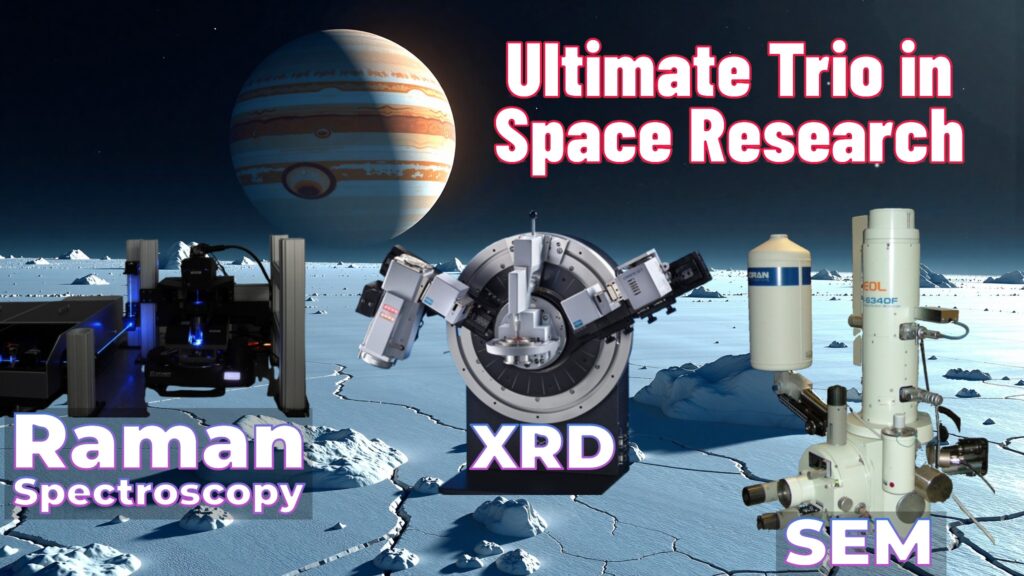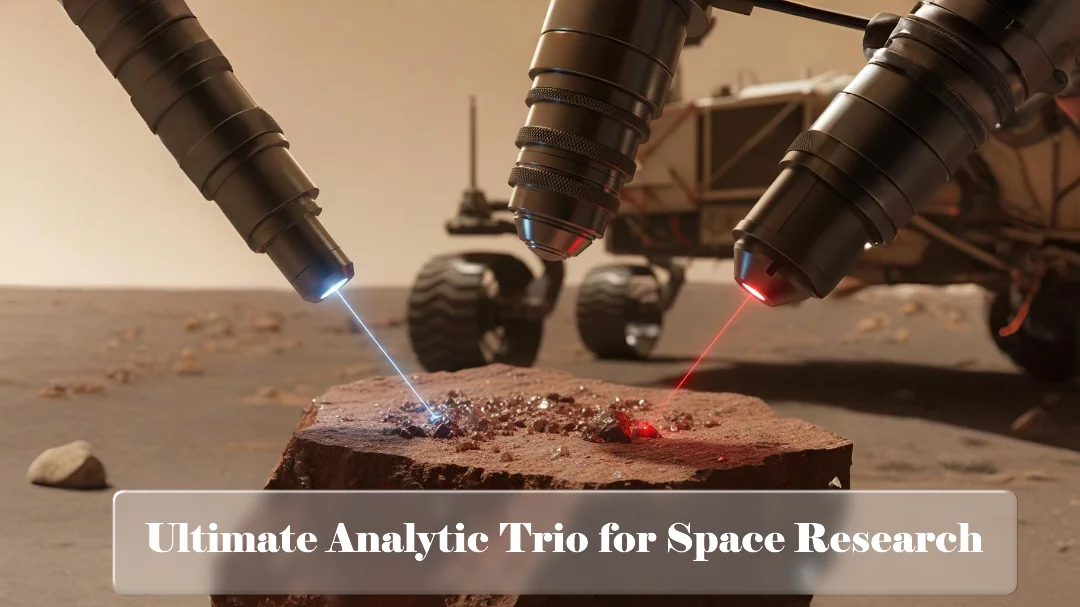XRD, SEM & Raman: The Ultimate Trio in Space Research
Decoding the Cosmos: How XRD, SEM & Raman Power Modern Space Exploration
Beneath the stark alien landscapes of Mars and within pristine asteroid samples lie the universe’s oldest secrets. A powerful trio of analytical techniques—XRD, SEM, and Raman spectroscopy—acts as our remote laboratory, transforming raw celestial material into profound discovery. This is the inside story of how these instruments on NASA’s rovers and landers are rewriting textbooks, revealing ancient waters, and hunting for the chemical fingerprints of life beyond Earth.
Table of Contents
The Martian dust holds secrets of ancient waters, and asteroid fragments contain the pristine story of our solar system’s birth. Unlocking these cosmic mysteries requires more than a rover’s camera; it requires a remote laboratory. X-ray Diffraction (XRD), Scanning Electron Microscopy (SEM), and Raman Spectroscopy form this formidable analytical trio, acting as the eyes and hands of scientists millions of miles away. They are the critical tools turning distant celestial bodies from points of light into places we can understand.
The Power Trio: How XRD, SEM & Raman Decode Extraterrestrial Secrets
To understand a planet’s history, you must first understand its building blocks. XRD, SEM, and Raman spectroscopy provide this fundamental analysis, each offering a unique and complementary lens to study extraterrestrial materials.
| Technique | Core Function | The Space Analogy | Key Mission & Example |
| X-Ray Diffraction (XRD) | Identifies crystalline structure and mineralogy. | The Mineral Identifier | Curiosity Rover (CheMin): Proved ancient Mars had conditions suitable for life by identifying clay minerals that form in water. |
| Scanning Electron Microscopy (SEM) | Generates nanoscale images of surface topography and composition. | The Ultra-HD Imager | Apollo Lunar Samples: Revealed the sharp, glassy nature of lunar regolith, critical for designing future lunar spacecraft and spacesuits. |
| Raman Spectroscopy | Detects molecular vibrations to identify chemical bonds and compounds. | The Molecular Fingerprint Scanner | Perseverance Rover (SHERLOC): Detects specific organic molecules and minerals, directly searching for potential biosignatures on Mars. |
X-ray Diffraction (XRD): The Mineral Identifier
XRD is indispensable for planetary geology. When X-rays hit a crystalline sample, they diffract in a unique pattern that acts as a fingerprint for its atomic structure. This allows scientists to definitively identify minerals.
Space Application: Onboard NASA’s Curiosity rover, the CheMin instrument uses XRD to quantify the minerals in Martian rocks. The discovery of clay minerals was a landmark finding, providing the strongest evidence that Mars once had persistent liquid water—a key ingredient for life.
Scanning Electron Microscopy (SEM): The Ultra-HD Imager
SEM provides an unparalleled view into the micro-world of space materials. By scanning a sample with a focused electron beam, it reveals stunning details about surface texture, grain size, and even elemental composition (when coupled with EDS).
Space Application: Analysis of Apollo moon dust with SEM showed it was composed of sharp, abrasive particles. This knowledge is crucial for the Artemis program, as it informs the design of equipment and habitats that can withstand the harsh lunar environment.
Curious about how SEM compares to other high-resolution imaging techniques? Dive deeper into the specifics in our guide: AFM vs. SEM: How to Choose the Best Microscopy Technique.
Raman Spectroscopy: The Molecular Fingerprint Scanner
Raman spectroscopy is a non-destructive workhorse for astrobiology. By measuring how laser light scatters from a molecule, it reveals its chemical structure. It is perfectly suited to detect fragile organic compounds and specific minerals without damaging precious samples.
Space Application: The SHERLOC instrument on the Perseverance rover uses Raman spectroscopy to map the distribution of organic molecules and minerals in Martian rocks, zeroing in on the most promising samples that may contain signs of past microbial life.
Mission Applications: The Trio in Action Across the Solar System
The true power of XRD, SEM, and Raman spectroscopy is revealed in their deployment across landmark space missions. From the red sands of Mars to the icy plumes of distant moons, this analytical trio is answering fundamental questions about our solar system. Here’s how they are applied in key areas of space research.

Martian Exploration: The Search for Habitability
The Mars rovers are essentially mobile geochemistry labs, and this trio is at their core.
- XRD & Raman: Onboard Curiosity and Perseverance, these techniques work in tandem. XRD (CheMin) identifies the mineral composition of rocks, while Raman (SHERLOC) hunts for specific organic molecules. Together, they determine if the environment could have supported life by confirming the presence of water-formed minerals and the building blocks of biology.
- SEM: While not yet deployed on the Martian surface, SEM is used on Earth to analyze Martian meteorites, providing ground-truth data on texture and micro-structures that complements rover findings.
Lunar & Asteroid Sample Science: Understanding Our Origins
Analyzing returned samples is a primary application for these techniques in terrestrial labs.
- SEM & XRD: For Apollo lunar samples and OSIRIS-REx asteroid samples, SEM is the first step, providing high-resolution imagery to select points of interest. XRD then reveals the exact mineralogy, telling us about the formation history and geological processes these bodies have undergone.
- Raman Spectroscopy: This technique is perfect for detecting trace organic compounds or specific mineral phases in these precious samples without causing any damage, preserving them for future study.
The Hunt for Life: Astrobiology on Icy Worlds
The next frontier for life is not on rocky planets, but within the subsurface oceans of icy moons.
- Raman & XRD: Future missions to moons like Europa or Enceladus plan to use Raman spectrometers to analyze ice grains and plumes for biosignatures directly. XRD could be used to characterize the crystalline structure of ice and any solid minerals, informing us about the ocean’s chemistry.
Engineering for Exploration: Surviving in Space
Beyond pure science, these tools are vital for the practicalities of space exploration.
- SEM: This is the workhorse for spacecraft material testing. By examining materials after exposure to the space environment (radiation, temperature cycles, micrometeoroid impacts), engineers can validate designs and ensure the structural integrity of future spacecraft, habitats, and spacesuits.
At-a-Glance: Application Matrix
| Research Field | Primary Technique(s) | Key Mission Example | Key Insight Gained |
|---|---|---|---|
| Mars Geology | XRD, Raman | Mars Curiosity Rover | Identification of clay minerals proving past watery environments. |
| Asteroid Analysis | SEM, XRD | OSIRIS-REx | Determining the mineral composition and resource potential of asteroid Bennu. |
| Lunar Geology | SEM, XRD | Apollo Program | Understanding the abrasive nature of lunar regolith for future Artemis missions. |
| Astrobiology | Raman | Mars Perseverance, Rosetta | Detection of organic molecules in cometary material and on Mars. |
| Icy Moon Analysis | Raman (Planned) | Future Europa Lander | Potential to detect biosignatures in subsurface ocean plumes. |
| Spacecraft Safety | SEM | All Missions | Testing material durability against the harsh space environment. |
See the Science: Your Guide to the Tools Decoding the Cosmos
Theory is one thing—but seeing these powerful instruments in action is where the true magic happens. In this episode from InSciLabTech, we take you inside the lab to demonstrate how XRD, SEM, and Raman spectroscopy are used to answer humanity’s biggest questions: Are we alone, and what’s out there?
Inside This InSciLab Tech Episode:
Join us for a hands-on exploration where we connect laboratory analysis directly to cosmic discovery. This video is your gateway to understanding the tools that are reshaping space research.
🔬 A Direct Look at the Trio in Action:
- XRD in the Lab & on Mars: See how we use XRD to crack the crystal code of minerals, just like the Curiosity rover does with Martian rocks.
- SEM’s Microscopic Universe: Get a close-up view as we use SEM to zoom in on the fine details of materials, revealing textures as unique as those in lunar dust and meteorites.
- Raman’s Chemical Fingerprint: Witness how Raman spectroscopy acts as a cosmic fingerprint scanner, identifying molecules that could be the key to finding ancient life clues.
🌌 Beyond Mars: Connecting to the Wider Solar System:
We also explore how this analytical trio is deployed across the solar system:
- Analyzing asteroid composition for mineralogy and resources.
- Studying cometary materials to understand our solar system’s origins.
- Probing extraterrestrial ice on moons like Europa for signs of habitability.
- Testing spacecraft materials to ensure they survive the journey.
This isn’t just about instruments; it’s about the process of discovery. We show you how data from a lab sample translates into a breakthrough on another world.
— The InSciLab Tech Team
Inspired by this? Subscribe to our YouTube Channel for more videos that bring cutting-edge research out of the lab and onto your screen!
The Future is in the Data: Your Role in the Next Discovery
The data from XRD, SEM, and Raman spectroscopy does more than fill textbooks—it fuels a new era of exploration. The discoveries made by this analytical trio are not the end of a journey, but the beginning. They pave the way for the next generation of scientists, engineers, and explorers to go even further.
Imagine being the one who operates the instrument that finds the first definitive evidence of past life on Mars. Or the researcher who analyzes a sample from an icy moon and detects the chemical signatures of a habitable ocean. This isn’t just science fiction; it’s the tangible career path that these tools are creating today.
The skills to understand and wield these techniques are your passport to the forefront of space discovery. Whether you’re analyzing data from a rover millions of miles away or preparing samples for a future sample-return mission, you can be part of the team that answers humanity’s oldest questions.
The next great cosmic secret won’t be found by a lone astronomer peering through a telescope, but by a researcher interpreting the spectral lines, diffraction patterns, and microscopic images from tools like XRD, SEM, and Raman.
Conclusion: The Keys to the Cosmic Vault
In the grand endeavor of space exploration, XRD, SEM, and Raman spectroscopy have proven to be more than just tools; they are our fundamental senses for interrogating the cosmos. They translate the unknown into the known, transforming alien landscapes into understood environments and mysterious samples into chapters of our solar system’s history.
From the mineralogy of Mars to the organic potential of icy moons, this powerful trio provides the hard evidence that guides our search for life and understanding of planetary evolution. As these technologies become more advanced and miniaturized, their role will only grow, leading the charge on future missions to the Moon, Mars, and beyond.
The universe is not keeping its secrets locked away. It is waiting for us to ask the right questions, with the right tools in hand. XRD, SEM, and Raman are the keys to asking those questions—and the journey to find the answers is just beginning.
Frequently Asked Questions (FAQ): XRD, SEM & Raman
How do XRD, SEM, and Raman spectroscopy work together?
They provide complementary data for a complete analysis. XRD identifies the crystalline mineral phases present. SEM shows the physical texture, morphology, and elemental composition at a micro-scale. Raman identifies specific molecular bonds, organic compounds, and non-crystalline materials. Used together, they tell the full story of a sample’s composition, structure, and history.
Which technique is best for finding signs of life (biosignatures)?
Raman spectroscopy is often considered the front-line tool for astrobiology. It is exceptionally good at detecting specific organic molecules and carbon-based compounds without destroying the sample, making it ideal for hunting the chemical fingerprints of past or present life.
Can these techniques be used on a planet like Venus with its harsh environment?
It’s extremely challenging but a key area of research. The high temperatures and corrosive atmosphere require specially hardened and sealed instruments. XRD and Raman are being developed for Venus missions, but they would need to operate from within a protected pressure vessel on a lander. SEM is not feasible on the surface but could be used on returned samples.
What’s the difference between analyzing a sample on Mars versus in an Earth lab?
On Mars (e.g., with a rover), the instruments are highly miniaturized, automated, and must operate remotely with limited power and data bandwidth. In an Earth lab, scientists have full-sized, more powerful instruments, can prepare samples meticulously, and can run iterative tests without constraints, allowing for much more detailed and conclusive analysis.
Why is SEM so important for future Moon missions?
SEM analysis of Apollo moon dust revealed it is sharp, glassy, and abrasive—a hazard for machinery, spacesuits, and human lungs. For the Artemis program and future lunar bases, SEM is critical for testing new materials and understanding how to mitigate the damaging effects of lunar regolith on equipment and infrastructure.
Are there any other analytical techniques used alongside this trio in space research?
Yes, frequently. Other key techniques include:
– LIBS (Laser-Induced Breakdown Spectroscopy): Used by the Curiosity rover (ChemCam) to quickly vaporize rock and analyze its elemental composition from a distance.
– Gas Chromatography-Mass Spectrometry (GC-MS): Used to separate and identify complex organic molecules in samples, a key tool for life detection.
– Microscopy (optical): Provides context images for selecting points of interest for SEM or Raman analysis.



One Comment